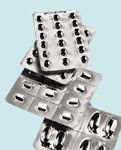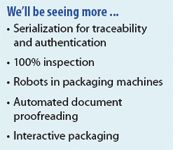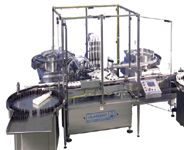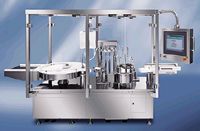Even Packaging Can Multitask
Interphex attendees found packaging machines and containers with increased functionality. This article contains online bonus material.
Packaging exhibitors at Interphex, which took place April 20–22, 2010, at the Javits Convention Center in New York, concentrated on increased functionality. Examples included extremely flexible packaging machines and inspection equipment capable of performing multiple tasks.

Hallie Forcinio
Flexible machines
In a first for North America, a fully automatic machine aseptically fills and seals presterilized bags. Rated at 60 bags/min, the unit fills volumes from 50 to 1000 mL. The space-saving design features a robotic infeed and outfeed, laser printing of variable data, print-quality confirmation by a camera-based vision system, shelf-life-extending evacuation or nitrogen flushing, a clean- or sterilize-in-place product path, and fully automated changeover (BFL 854 aseptic bag filler–sealer, Plümat North America, Naperville, IL).
A precise femtosecond laser applies tiny, two-dimensional data-matrix codes to transparent containers. The laser's ultrashort pulses do not mar the surface of the glass or plastic, but change its refractive index to mark the container without additives or emissions. Resulting codes are machine readable on full or empty vials, but only can be seen by the naked eye when illuminated at the correct angle. Codes identify the container for subsequent labeling operations and can be integrated with secondary packaging for track-and-trace requirements (TRACKinside laser coding and LineDirector software, Crest Solutions, Cork, Ireland).

TETRA IMAGES/GETTY IMAGES
A vacuum system gently transfers solid dosage forms from bulk boxes, bag-lined drums, bags, or intermediate bulk containers (IBCs) to the hoppers of filling machines. The automated system eliminates manual handling, lifting, and climbing to reach hopper heights, as well as the need to suspend IBCs above packaging machines. The system also dedusts as it transfers, thus eliminating the need for a separate dedusting operation. For flat-bottomed drums, which are difficult to empty completely, a collar on the vacuum wand draws the bag liner inward to shift remaining product to the center for capture by the vacuum. If necessary, the system can use conditioned air or be sealed to limit operator exposure to the product (No Tip Unloader, Volkmann, Neuss, Germany).
Linear synchronous motor technology on a modular conveyor precisely moves, positions, and tracks loads weighing as much as 2 kg with no pressure accumulation. The system can move in either direction and conveys product on small pucks at speeds of up to 2 m/s, about seven times faster than standard conveyors. As many as nine pucks can be in motion per meter. With no belts, chains, gears, wheels, or external sensors, the washdown-compatible system contains few moving parts. Software simulation and configuration tools and plug-and-play track components simplify setup and subsequent reconfigurations. Track parts include 90° and 180° curves, 180° over–under curves, 0.25-m and 1-m straight tracks, and left and right diverges (MagneMover Lite conveyor, MagneMotion, Devens, MA).

Modular monoblocs
A high degree of flexibility is built into a modular monobloc for filling and finishing rigid containers. Capable of handling round or square containers ranging in size from 10 to 1000 mL, the servo-driven system can be equipped with either a peristaltic or piston pump. An optional high-efficiency particulate air (HEPA) filtration system provides positive-pressure airflow in the filling area (Monobloc fill–finish packaging system, Filamatic, Baltimore, MD).

The servo-driven Filamatic Monobloc fillâfinish packaging system handles round or square containers ranging in size from 10 to 1000 mL. (PHOTO IS COURTESY OF FILAMATIC.)
Another highly flexible monobloc fills and closes microtubes or bottles and can change from one to the other in 30 min. Capable of filling volumes as great as 250 mL, the system's maximum speed is 45 containers/min. The microtube setup consists of a vibratory bowl to orient tubes, a linear filling line, and screw capping. Bottles rely on rotary turntables at the infeed and outfeed and crimp capping. Hygienic design, HEPA filtration, and compatibility with barrier systems or isolators make the system suitable for sterile products (P1520-BT monobloc, M&O Perry Industries, Corona, CA).
Yet another monobloc fits the needs of laboratoriess, pilot plants, and clinical-trial packaging. It can fill from 1 to 100 mL at speeds as high as 45 containers/min. Capable of filling, stoppering, and crimping aluminum caps, the system enables tool-free changeover to be completed in less than 10 min. The single-operator machine is designed for cleanroom environments (Model FSAS—2205 Tabletop, Chase-Logeman, Greensboro, NC).
Clinical trials and low-volume applications also are addressed by a highly flexible vial filler equipped with two robots. The first robot transfers a vial from the infeed and sets it on a weigh cell for filling. After the accuracy of the fill is verified, the other robot moves the vial to the stoppering station. Interchangeable filling options include piston, peristaltic, and rolling-diaphragm pumps. Personal-computer-based control ensures precise fills and minimal product waste. The unit handles as many as 60 glass or plastic containers per minute. Servo control automates changeover, which involves a minimum of change parts. A small footprint and isolator-ready construction enhance functionality (MHI vial-filling and -closing machine, Bosch Packaging Technology, Waiblingen, Germany).

The MHI vial-filling and -closing machine from Bosch is targeted toward low-volume applications and suited for clinical-trial packaging. (PHOTO IS COURTESY OF BOSCH.)
A syringe-assembly machine inserts the plunger rod into 1-, 2- or 5-mL syringe bodies and applies labels. The compact machine also incorporates a printer to print a lot number and expiration date on the label and a vision system to verify the information and label placement. Three models handle speeds of 100, 200, and 400 syringes/min. An inclined exit raises the syringes to the level of the thermoformer. Options include assembly of back stops and safety devices (Hasta plunger-rod inserting machine, MG America, Fairfield, NJ). The plunger-rod inserting machine can be integrated with a complete line, including a syringe denester, thermoformer, cartoner, and case packer.
Multifunctional inspection
Quality control always is a prime concern, and pharmaceutical manufacturers continue to express high levels of interest in flaw-detection equipment. Particularly notable is the growing number of multifunctional systems, many capable of providing 100% inspection at line speeds.
A low-power diode-laser system with as many as four heads checks vials of freeze-dried, liquid, or powder products for raised stoppers and headspace moisture and oxygen. Because the laser can be tuned to match the wavelength of the gas, it also can be set to detect nitrogen levels. Stand-alone or on-line configurations handle single vials or trays. Container sizes range from 1 to 200 mL. The system can check as many as 600 containers/min (high-speed headspace-inspection machine, Lighthouse Instruments, Charlottesville, VA).
Raised stoppers also can be detected by camera-based systems. Capable of measuring variations of ±1 mm, an intermittent-motion unit holds vials steady to ensure that good images are captured. The system bolts to existing capping equipment and also analyzes headspace or checks for the presence of moisture with the addition of a laser or near-infrared module, respectively. Other options include application and verification of lot numbers (vial-inspection platform, Genesis Packaging Technologies, Exton, PA).
Improved operation and connectivity characterize a new leak detector for syringes and vials. Electronic vacuum control increases precision and shortens cycle time, enabling the detection of leaks as small as 0.005 cm3 per minute. To check for leaks, packages are placed in a test fixture inside a test chamber and a vacuum is pulled. If leaks or other defects are present, the equipment will register changes in absolute and differential vacuums. The nondestructive test is more sensitive than the traditional dye-ingress test (VeriPac 455 leak detector, Packaging Technologies and Inspection, Tuckahoe, NY).
Another multifunctional system checks headspace oxygen with a laser, confirms container–closure integrity with a vacuum, and measures lyophilized-cake quality and moisture content with near-infrared technology. An integrated camera performs surface inspections and verifies two-dimensional data matrix codes. A timing screw–starwheel arrangement provides positive container handling and rejection (Wilcomat R 36 MC–LFC–V–HAS–NIR leak tester, Wilco, Wohlen, Switzerland).
Microflow technology detects leaks as small as 0.2 μm in blister packs, pouches, vials, syringes, cartridges, and other flexible and rigid packages. Available in two designs for sterile and nonsterile products, the patented system checks for gross and fine leaks by measuring the mass of molecules in motion. Flow rate is proportional to defect size. Inline models run at speeds as high as 200 packs/min (Model ME2 packaging leak tester, ATC, Indianapolis, IN).

ATC's ME2 microflow leak tester identifies containerâclosure integrity problems in packages of injectable products. (PHOTO IS COURTESY OF ATC)
For solid dosage forms, a patented arrangement of mirrors and three cameras captures images that are combined to show the entire surface of the capsule, including each end. As a result, the vision system detects surface flaws and nonconforming colors, confirms the presence of the tamper-evident sealing band, and verifies print quality without rotating the capsule. Three plug-and-play change parts make it possible to inspect capsule sizes from #00 to #5. Changeover is toolless and takes less than an hour. Capable of handling 2000 capsules/min, two systems are already installed—one in India and one in Taiwan (Proditec InspeCaps 150, Symetix, Walla Walla, WA).

The InspeCaps 150 single-file vision system inspects opaque, transparent, or translucent capsules when full or empty. (PHOTO IS COURTESY OF PRODITEC.)
Another camera-based system provides similar inspection capabilities on slat fillers. Each camera in the multicamera system checks a 4-in area for broken, missing, and different color tablets at a speed of 7 slats/s, which is equivalent to 400 150-count bottles/min. The turnkey vision system includes lighting and brackets (Slat Counter Inspector, Optel Vision, Quebec, Canada).
Robotic positioning with a multicamera vision system automates inspection of liquid products in ampuls, vials, cartridges, or syringes and lyophilized product in vials ranging in size from 8 to 80 mm in diameter and as tall as 200 mm. The robot picks up and rotates the liquid-filled container to check for particulates and fill level. It inspects the cake surface of lyophilized products. Optional checks include surface defects, stopper presence, aluminum-cap centering and crimping, and needle-shield condition (Mario inspection system, Dabrico, Bourbonnais, IL)
For text and labeling inspection, an upgraded vision system centralizes management in a client–server configuration to simplify global deployment and reduce information-technology costs. The Windows-based system can compare one master with multiple samples or multiple masters with multiple samples at faster scanning and inspection speeds than its predecessors. A click of the mouse groups errors for review (Docu-Proof Enterprise Client-Server Text Inspector, Global Vision, Montreal).
A multipage proofreading system enables batch processing of booklets, instruction manuals, and other documents to reduce proofreading time from weeks to days or minutes. Compensating for magnification differences, distortion, and ink bleed-through, the system can compare two digital files (i.e., PDFs), a digital file and a scanned document, or two scanned documents and check all aspects, including text characters, graphics, charts, and photos. Pages of different sizes may be scanned through a double-sided autofeed scanner.
After the scan is completed, an operator reviews discrepancies the machine flags, accepts or rejects them, and may add comments about them. Review sessions can be saved, closed, and reopened as needed. A rework folder stores information about major problems like out-of-order pages. The system includes a high-quality, autofeed color scanner, software, software license and warranty, 20-in. liquid-crystal display monitor, and personal computer with Windows, Microsoft Office, and Adobe Acrobat software, plus on-site installation and training. A validation package may be purchased as an option (Avia Infinity Multi-Page proofreading system, Mnemonics, Mount Laurel, NJ).
Other innovations
Serialized identification, usually undertaken for traceability and distinguishing purposes, also can support interaction with consumers and sales-generating loyalty programs. Using a smart-phone application, field investigators and consumers can scan or enter the code on a package, authenticate the product, and track its history, potentially back to the raw materials used in the batch.
For consumers, the code scan also can prompt the delivery of promotional information or connection to a chat function or customer service. Other possible loyalty-program services include instructions about how to take the product, dose reminders, and refill alerts. The smart-phone application and the associated software and services not only provide enhanced value to the consumer, but also link brand managers directly to consumers through dashboards that show data such as who purchased the product, where the product was purchased, and what price was paid. Deployable in 30 days without a large time commitment by corporate information-technology personnel, the software also can connect physicians and pharmacists to prescribing information (Brand Loyalty and Integrity Services, Covectra, Southborough, MA).

Scanning or inputting a code into a smart phone can authenticate product through Covectra's Brand Loyalty and Integrity Services. (PHOTO IS COURTESY OF COVECTRA)
A staked-needle syringe with a tamper-evident closure eliminates contact between the drug and needle and offers a patient-friendly thin needle as heavy as 32 gauge. A specially designed seal keeps product from flowing into the needle until the needle shield is removed. Suitable for sensitive drugs, the syringe is free of leachables from adhesives and tungsten because the geometry of the glass barrel does not require tungsten in the glass-forming process. Domestic production is scheduled to begin before the end of 2010. The syringe is delivered with standard nests and tubs and can be filled on standard filling lines (Schott InJentle staked-needle syringe, Schott Pharmaceutical Systems, Lebanon, PA).
Another syringe-related development features a removable label for the latest version of a safety syringe. The peel-off part of the label can be stuck to the patient chart to provide a record of the injection (Needle-Trap syringe, Schreiner Medipharm, Blauvelt, NY).
A small, flat, four-side-sealed pouch dispenses unit doses ranging from less than 1 to 20 mL. A single dose of gel, cream, lotion, or ointment dispenses when the two ends are pressed together and the pouch snaps open along a score line. Because virtually no residue remains, overfill is not required to ensure a full dose. The structure of the pouch material varies, but it typically consists of a multilayer laminate with a layer of foil (Snap! package, Tapemark, West Saint Paul, MN). Options include a side-by-side configuration for two doses, a two-chamber setup for ingredients that can't be mixed until use and a design with a built-in applicator (Snap! Duet, Snap! Dual Chamber, and Snapplicator, Tapemark).
A new blister-packaging option, polyester film, has been developed as a drop-in replacement to PVC. Compatible with the lidstock, equipment, and tooling used to produce PVC blisters, the polyester film offers equal or better thickness distribution, punches and perforates cleanly, and exhibits good lay-flat properties and brilliant clarity. Its tensile strength is 10% higher than that of PVC, and its elongation at break is 300% better. Its rigidity is a bit lower, and polyester blisters are expected to have a child-resistance rating at least equal to that of vinyl. A forming temperature that's about 15 °C lower than that of PVC saves energy and shortens cycle time. In addition, polyester's lower specific gravity results in higher yield. This 8% higher yield, potential for downgauging, and faster throughput offsets polyester's higher price, thus making the adoption of the chloride-free material essentially cost-neutral. Enhanced barrier properties can be achieved through lamination with Aclar or ethylene-vinyl alcohol or through coating with polyvinylidene chloride. Gauges range from 191 to 450 μm (Pentapharm kpVantage High-Performance Polyester Films, Klöckner Pentaplast, Gordonsville, VA).

New polyester films from Klöckner Pentaplast provide an alternative to polyvinyl chloride in blister packaging. (PHOTO IS COURTESY OF KLÃCKNER PENTAPLAST)
Hallie Forcinio is Pharmaceutical Technology's Packaging Forum editor, 4708 Morningside Drive, Cleveland, OH 44109, tel. 216.351.5824, fax 216.351.5684, editorhal@cs.com.

Transformations in Drug Development for Cell and Gene Therapies
March 28th 2025As a recognized leader in immunophenotyping for clinical trials, Kevin Lang from PPD discusses how spectral flow cytometry is transforming drug development, particularly in cell and gene therapies like CAR-T. He also dives into his award-winning research, including his 2024 WRIB Poster Award-winning work, and his insights from presenting at AAPS PharmSci360.
Advancing Clinical Trials with Spectral Flow Cytometry: A Conversation with Kevin Lang
March 28th 2025As a recognized leader in immunophenotyping for clinical trials, Kevin Lang from PPD discusses how spectral flow cytometry is transforming drug development, particularly in cell and gene therapies like CAR-T. He also dives into his award-winning research, including his 2024 WRIB Poster Award-winning work, and his insights from presenting at AAPS PharmSci360.